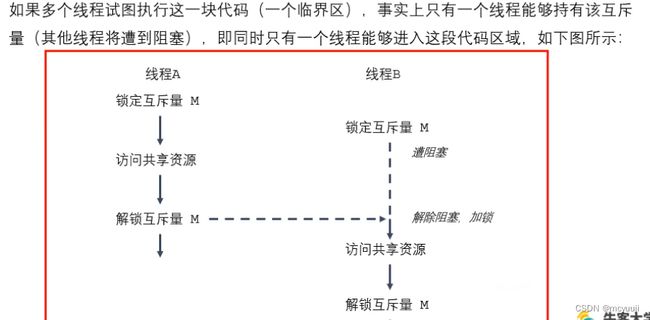C++linux高并发服务器项目实践 day11
C++linux高并发服务器项目实践 day11
- 线程同步
-
- 互斥锁
- 死锁
- 读写锁
-
- 读写锁相关操作函数
- 生产者消费者模型
- 条件变量
- 信号量
线程同步
线程的主要优势在于,能够通过全局变量来共享信息。不过,这种便捷的共享是有代价的:必须确保多个线程不会同时修改同一变量,或者某一线程不会读取正在由其他线程修改的变量
临界区是指访问某一共享资源的代码片段,并且这段代码的执行应为原子操作,也就是同时访问同一共享资源的其他线程不应中断该片段的执行
线程同步:即当有一个线程在对内存进行操作时,其他线程都不可以对这个内存地址进行操作,直到该线程完成操作,其他线程才能对该内存地址进行操作,而其他线程则处于等待状态
/*
使用多线程实现卖票案例
有3个窗口,一共是100张票
*/
#include 互斥锁
为避免线程共享变量时出现问题,可以使用互斥锁(mutex 是 mutual exclusion的缩写)来确保同时仅有一个线程可以访问某项共享资源。可以使用互斥锁来保证对任意共享资源的原子访问
互斥锁有两种状态:已锁定(locked)和未锁定(unlocked)。任何时候,至多只有一个线程可以锁定该互斥锁。试图对已经锁定的某一互斥锁再次加锁,将可能阻塞线程或者报错失败,具体取决于加锁时使用的方法
一旦线程锁定互斥锁,随机称为该互斥锁的所有者,只有所有者才能给互斥锁解锁。一般情况下,对每一共享资源(可能由多个相关变量组成)会使用不同的互斥锁,每一线程在访问同一资源时将采用如下协议:
- 针对共享资源锁定互斥锁
- 访问共享资源
- 对互斥锁解锁
int pthread_mutex_init(pthread_mutex_t * restrict mutex,const pthread_mutexattr_t *restrict attr);
- 初始化互斥锁
- 参数:
- mutex:需要初始化的互斥锁变量
- attr:互斥锁相关的属性,一般使用默认,传递NULL
- restrict:C语言的修饰符,被修饰的指针,不能由另外一个指针进行操作
int pthread_mutex_destroy(pthread_mutex_t *mutex);
- 释放互斥锁的资源
int pthread_mutex_lock(pthread_mutex_t *mutex);
- 加锁,阻塞的,如果有一个线程加锁了,你们其他的线程只能阻塞等待
int pthread_mutex_trylock(pthread_mutex_t *mutex);
- 尝试加锁,如果加锁失败,不会阻塞,会直接返回
int pthread_mutex_unlock(pthread_mutex_t *mutex);
- 解锁
#include 死锁
两个或两个以上的进程在执行过程中,因共享资源而造成的一种相互等待的现象,若无外力作用,它们都将无法推进下去。此时称系统处于死锁状态或系统产生了死锁
死锁的几种场景:
- 忘记释放锁
- 重复加锁
- 多线程多锁,抢占锁资源
读写锁
在对数据的读写操作中,更多的是读操作,写操作较少。为了满足当前能够允许多个读出,但只允许一个写入的需求,线程提供了读写所来实现
读写锁的特点:
- 如果有其他线程读数据,则允许其他线程执行读操作,但不允许写操作
- 如果有其他线程写数据,则其他线程都不允许读、写操作
- 写是独占的,写的优先级更高
读写锁相关操作函数
读写锁的类型 pthread_rwlock_t
int pthread_rwlock_init(pthread_rwlock_t *restrict rwlock,const pthread_rwlockattr_t *restrict attr);
int pthread_rwlock_destroy(pthread_rwlock_t *rwlock);
int pthread_rwlock_rdlock(pthread_rwlock_t *rwlock);
int pthread_rwlock_tryrdlock(pthread_rwlock_t *rwlock);
int pthread_rwlock_wrlock(pthread_rwlock_t *rwlock);
int pthread_rwlock_trywrlock(pthread_rwlock_t *rwlock);
int pthread_rwlock_unlock(pthread_rwlock_t *rwlock)
/*
案例: 8个线程操作同一个全局变量
3个线程不定时写一个全局变量,5个线程不定时的读一个全局变量
*/
#include 生产者消费者模型
条件变量
条件变量的类型 pthread_cond_t
int pthread_cond_init(pthread_cond_t *restrict cond,const pthread_condattr_t *restrict attr);
int pthread_cond_destroy(pthread_cond_t *cond);
int pthread_cond_wait(pthread_cond_t *restrict cond,pthread_mutex_t *restrict mutex);
- 功能:阻塞函数,调用了该函数,线程会阻塞。
int pthread_cond_timedwait(pthread_cond_t *restrict cond,pthread_mutex_t *restrict mutex,const struct timespec *restrict abstime);
- 功能:等待多长时间,调用了这个函数,线程会阻塞,直到指定的时间结束
int pthread_cond_signal(pthread_cond_t *cond);
- 唤醒一个或者多个等待的线程
int pthread_cond_broadcast(pthread_cond_t *cond);
- 唤醒所有的等待的线程
#include 信号量
信号量的类型 sem_t
int sem_init (sem_t *sem,int pshared,unsigned int value);
- 功能:初始化信号量
- 参数:
- sem:信号量变量的地址
- pshared: 0 用在线程 , 非0 用在进程
- value:信号量中的值
int sem_destroy(sem_t *sem);
- 功能:释放资源
int sem_wait(sem_t *sem):
- 功能:对信号量加锁,调用一次对信号量的值-1,如果值为0,就阻塞
int sem_trywait(sem_t *sem);
- 功能:
int sem_timedwait(sem_t *sem,const struct timespec *abs_timeout);
int sem_post(sem_t *sem);
- 对信号量解锁,调用一次对信号量的值+1
int sem_getvalue(sem_t *sem,int *sval);
#include 
